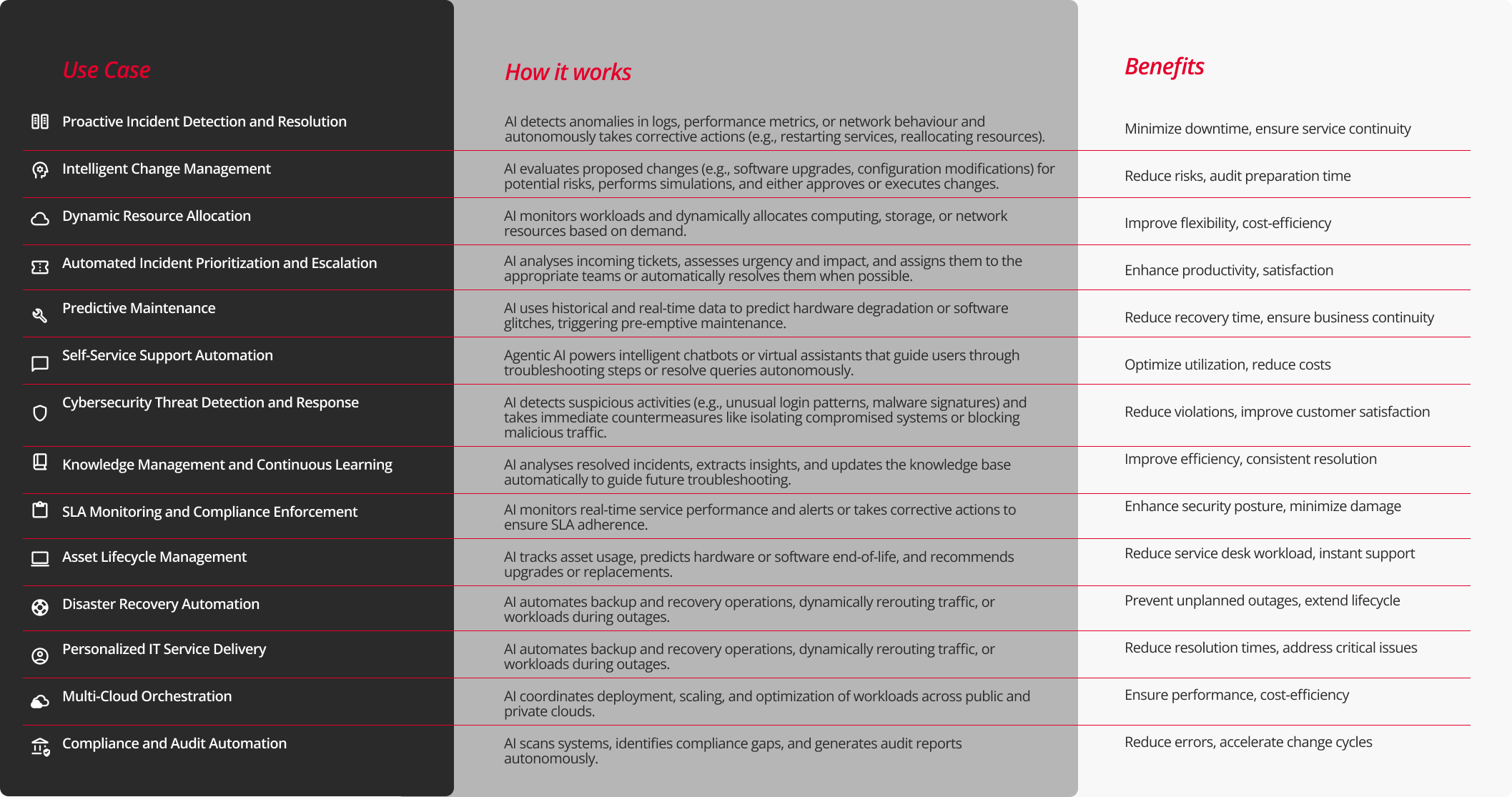In today’s innovation led environment where businesses rely heavily on technology to stay competitive, the management of IT systems is becoming increasingly complex. From network infrastructure and end user compute, data management and storage, software maintenance and management and the holistic security of all of this ecosystem, there is no shortage of IT challenges to overcome.
This is where modern service management and associated tooling platforms come into play. These holistic platforms enable businesses to streamline their operations, reduce costs, and stay ahead of the curve. In this guide to modern service management, we will explore what is managed services, how modern IT managed services are structured and operate, and how various tools can enhance their effectiveness and drive a better and more efficient client/user experience.
1.What is Managed Services
2.Key IT functions covered by managed services
3.Modern Service Management
4.Best Practices for ITSM
5.Benefits of modern service management
6.What’s Next for Managed Services? Unlocking Automation with Agentic AI
What is managed services
As we all know managed services refer to outsourcing core or niche IT functions to an external service provider, known as a Managed Services Provider (MSP). IT departments often face issues like slow computer and network performance, password problems, internet issues, data loss, security breaches, slow IT support response times and other common IT issues.
Managed services providers can help by managing hardware, software, implementing security measures, automation, and offering 24/7 support. The goal is to use the MSP’s core engineering and subject matter expertise (SME) capabilities and experience to provide services which deliver a proactive service for IT management, rather than relying on reactive fixes when things go wrong. This allows businesses to benefit from continuous monitoring, rapid problem resolution, and access to specialised expertise and best in class processes, methodologies, and tooling all while reducing the burden on expensive internal resources to allow them to be free to work on core business capability functions.
Key IT functions covered by managed services
- Hybrid Cloud solutions and management involves the integration and management of both private and public cloud environments to provide businesses with greater flexibility, scalability, and cost-efficiency in their IT operations.
- Cyber resilience, data backup and disaster recovery: strategies and technologies to ensure the protection, backup, and quick recovery of data and IT systems in the event of cyber threats or disasters.
- Software management, patching, and updates: involving the continuous process of maintaining, updating, and securing software applications to ensure they function efficiently, remain secure, and are up to date with the latest features and fixes.
- Network management and monitoring: involve the continuous oversight and maintenance of a network’s performance, security, and reliability to ensure optimal operation and quick resolution of any issues.
- Cybersecurity and data governance services involve protecting digital assets, ensuring regulatory compliance, and managing data responsibly through threat , encryption, access control, incident response, compliance management, data governance, and security awareness training.
- Application development and maintenance services: involve the continuous process of designing, developing, and maintaining software applications to ensure they meet business needs, remain functional, and are updated with the latest features and security patches.
- Helpdesk and IT support involve helping and providing solutions to users for their IT-related issues, ensuring smooth and efficient operation of IT systems.
Modern service management
Traditional managed services in today’s complex Enterprise IT ecosystem rely heavily on expensive and limited subject matter expertise. Modern Service Management, however, uses enhanced technologies like Ergo Connect, powered by ServiceNow, which integrates client contact, IT service management (ITSM), Remote monitoring management (RMM), and cybersecurity management tools.
This alleviates the need for organisations to stay current with non-core technology, allowing them to focus on their core business. Another key tool is Amazon Connect, a cloud-based contact centre service, manages customer interactions and logs, ensuring prompt service when integrated with Ergo Connect.
Traditionally, service desks were reactive, addressing issues as they arose. With modern technologies, they have become proactive and strategic. Automation and AI tools now predict and prevent issues, reducing downtime and enhancing service quality. Advanced analytics provide insights into user behaviour, enabling personalised support. Self-service portals and virtual assistants offer instant solutions, reducing the need for human intervention.
Modern service desk leverage Automation, Machine Learning, and Generative AI to deliver services more efficiently, reducing reliance on highly skilled and expensive resources.
AI and automation are essential for modern service management, streamlining operations, reducing costs, and enhancing customer and employee experiences. AI tools analyse data to predict and prevent issues, minimising downtime and ensuring service continuity. Automation reduces manual processes, allowing IT staff to focus on complex issues.
AI-driven chatbots provide instant support, and generative AI enhances service management by understanding user intent and generating contextual responses. AI-powered analytics offer real-time insights into customer satisfaction, enabling continuous improvement in service delivery.
These services also allow for more improved and efficient channels of contact and self-service capabilities through improved knowledge and operational management and finally using large language models and the collection of rich data, reporting and customer satisfaction (CSAT) recording capabilities are becoming near real-time through the use of performance analytics and sentiment analysis.
Best practices for ITSM
Implementing best practices in IT Service Management (ITSM) is crucial for ensuring efficient and effective IT operations. Here are some key best practices we consider:
- Service-Oriented Approach: Deliver IT services that align with business goals and add value to the organisation.
- Implement ITIL: Use ITIL best practices to standardize processes and improve service quality and customer satisfaction.
- Continuous Improvement: Regularly review and enhance ITSM processes to ensure they remain effective and efficient.
- User Experience: Ensure IT services are user-friendly, provide self-service options, and meet the needs of end-users.
- Knowledge Management: Maintain a comprehensive knowledge base to support ITSM processes and reduce resolution times.
- Collaboration: Foster communication between IT teams and other departments to ensure seamless service delivery.
- Measure and Enhance IT Operations: KPIs, OLAs, and SLAs are essential for measuring and enhancing IT operations and service delivery
Benefits of modern services management
Modern organisations are rapidly increasing their digital services to meet industry demands and employee expectations. This surge leads to a higher number of incidents from both users and the infrastructure. Scaling people and manual processes to manage this volume is impractical, but AI-powered automation can manage these incidents as they occur or even prevent them proactively.
Generative AI, combined with traditional ML/AI, enhances service management, improving employee experience and productivity. It helps understand user intent, synthesize knowledge, and generate contextualised responses. Incorporating Generative AI in service management platforms allows MSPs to enhance self-service search, generate incident summaries, and create resolution notes, enabling IT staff to focus on complex issues.
Knowledge creation and management benefits
Many routine incidents can be deflected with knowledge content, but this requires agents to spend time creating relevant articles, time that they often do not have. With AI knowledge generation, articles can quickly be generated and published in a knowledge management system for agents and/or employees to reference and learn from. This will help close the knowledge gap found in many organizations among agents and employees.
Implementing Tooling with embedded AI capabilities stands to transform how you create and manage knowledge articles in the following ways:
1.Faster turnaround time for knowledge article creation
AI KM accelerates the creation of knowledge articles by leveraging AI to draft articles based on case details. This reduces the time agents spend on documentation, allowing them to focus on resolving issues.
2. Increased self-service and deflection
By making relevant knowledge articles more readily available, AI KM empowers users to find solutions on their own. This enhances the self-service experience and reduces the number of tickets submitted to support teams.
3. Faster resolution time on tasks
With reduced knowledge gaps and more accurate articles for troubleshooting, tasks can be resolved more swiftly. And greater efficiency = improved customer satisfaction and operational effectiveness.
Case summarisation & text-to-code related benefits
Tooling Implemented with embedded AI capabilities also allows agents and engineers to automatically summarize customer interactions by analysing chat logs and call transcripts. Using large language models (LLMs), fine-tuned with specific customer data, summaries that capture the essence of each conversation can be generated automatically.
Case summarisation minimises manual work to boost productivity and accelerate customer outcomes.
1. Case summarisation uses generative AI to read and distil case information across IT and customer service cases, including customer or incident details, previous touchpoints, actions taken by involved parties, and the eventual resolution, to create case summary notes in seconds. Simplifying this “mandatedbutmanual” process can allow for quicker handoffs between internal teams, help increase productivity and create more streamlined resolutions for customers and employees alike. Additionally, by simplifying these manual processes, employees can focus on more complex assignments and projects.
2.AI Search summarisation
With the introduction of AI search, native search functionality became akin to popular consumer-grade offerings. AI Search results combined with generative AI, instead of search results, you get answers. This is helpful for employees and customers alike to find the answers they need and not create requests or incidents for agents.
3. Chat summarisation
Speed up transfers and take the chat transcript between the employee and a Virtual Agent, or even live agent, and summarize it. This is helpful for agents who need to pick up where the last agent left off and quickly get up to speed to tackle the incident, reducing MTTR and repetitive questions for the requestor.
4. Incident summarisation
When a request is not submitted through chat, the first responder may not be the right agent to oversee the incident. In this case, the next agent needs to quickly understand the issue and the steps taken so far so they can best tackle resolution. With incident summarization, the issue, actions taken, and potential next steps are neatly summed up for the next agent to quickly ingest before beginning to resolve the incident.
5. Resolution Notes Generation
When an incident is resolved, ITIL best practices state providing detailed resolution notes. With this feature, Agents are given an opportunity to review and submit auto-generated resolution notes based on steps taken, parties involved, and successful resolution actions. Not only is the resolution procedure streamlined but ensures agents in the future can reference past incidents for help.
6. Text-to-code accelerates pro and low-code development with generative AI.
Service automation developers often face repetitive and time-consuming work, creating the same code for routine commands. With text-to-code, developers can write plain, natural language text descriptions of the type of code they want; generative AI within the Platform will convert the text into high quality code suggestions, and in some cases complete code, which is shared inline to review, edit, and implement. Text-to-code helps ensure every corner of the enterprise can create seamless coding experiences that can deliver fast development and increased productivity.
What’s next for services management? Unlocking automation with agentic AI
As digital transformation evolves further and businesses continue searching for ways to improve efficiency, reduce operational costs, and enhance customer satisfaction. Service management, a critical backbone of these industries, must further evolve and adopt new automation technologies to achieve these goals. One of the most transformative developments in this space is the emergence of “agentic AI.” This paradigm, centred around autonomous and goal-driven artificial intelligence, has the potential to revolutionize service management by enabling systems to take initiative, adapt dynamically, and make informed decisions.
Potential Use Cases for Agentic AI in IT Service Management
Agentic AI can transform IT Service Management (ITSM) by autonomously driving intelligent decisions and actions, reducing human dependency, and increasing efficiency. Here are some key use cases for Agentic AI in ITSM:

As you can clearly see Agentic AI in ITSM goes beyond simple automation by enabling proactive, adaptive, and intelligent management of IT services. These use cases demonstrate its potential to redefine efficiency, reliability, and innovation in IT operations.
In conclusion, the integration of Agentic AI within IT Service Management (ITSM) represents a paradigm shift, leading the way towards a future where IT operations are not only automated but also intelligently managed. By adopting these advanced AI-driven solutions, organizations can anticipate and swiftly respond to dynamic operational requirements, paving the path for a more resilient and innovative IT landscape. The strategic application of AI in ITSM is poised to unlock unprecedented levels of operational excellence and business agility and Ergo Connect remains at the forefront of this evolution delivered at a pace which aligns with our client’s maturity and risk management profile to best prepare them for today while planning for tomorrow and what the future will bring.

Ready to elevate your service management?
At Ergo, we take the complexity out of IT management so you can focus on what matters most—growing your business. Whether you need 24/7 support, enhanced security, or a scalable IT strategy, our managed services can help.
Let’s discuss how we can tailor a solution for your business.
Contact Us





